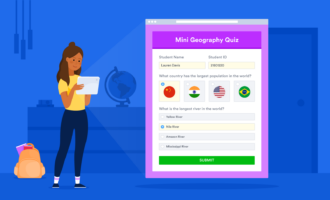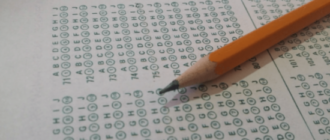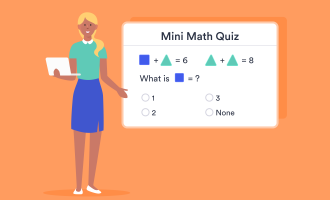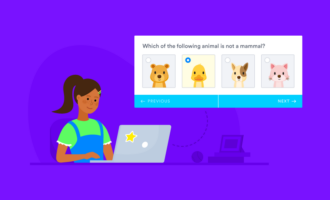7 types of quiz questions
Taking a test is part of being a student, whether that student is sitting in a classroom or sitting at home in front of a computer. Since the COVID-19 pandemic, distance learning has dominated the education landscape. In fact, when schools shut down around the world in early 2020, nearly 1.2 billion students were forced out of the classroom.
Teachers had to quickly shift their educational curriculum to an online model — and that included remote testing and quizzes, one of the most important tools in e-learning. The beauty of quizzes is the wide variety of ways you can pose questions to test a student’s knowledge of a certain topic. Below are seven types of quiz questions you can incorporate into your distance learning plan.
1. Multiple-choice questions
Multiple-choice questions are one of the most effective and widely used types of quiz questions. With this format, you pose a question and offer several possible answers. The student has to pick the right one. This type of question tests a student’s knowledge. The answer shouldn’t be easy to guess.
Make sure there’s only one best answer distributed randomly throughout the other “distractor” answers. Ensure that the question and the answers are clear. Try to avoid a “none of the above” option because that doesn’t always accurately show whether or not the student knows the correct answer.
Pro Tip
Create a quiz form for your students with JotForm. Customize a free template to start collecting responses from any device. Great for distance learning.
2. True or false
This type of question is straightforward. The student has to choose whether or not the statement you provide is true or false.
These questions are best used when the objective is to have the student judge a fact, concept, example, or principle. This isn’t the time to interject opinion or interpretation into the questions, and it’s important to not make vague or ambiguous statements.
Each question should focus on only one important idea or one relationship between ideas so that you can determine exactly what the student does or doesn’t understand.
3. Short answer
Unlike multiple-choice questions, where students are given options from which to select the answer, short-answer questions require the student to supply the correct answer on their own. These types of questions greatly reduce the chance of a student getting a question right by guessing.
To write an effective short-answer question, be sure to use a direct question and word it in a way that presents a clear, meaningful problem. It’s also important to present the question so that only a single, clear-cut answer is acceptable. This helps you avoid accepting any answer that could be correct in a broadly defined situation.
4. Multiple-response questions
Like multiple-choice questions, multiple-response questions present students with multiple answers, but these questions call for students to select all of the correct answers from several options presented. This format is more challenging than multiple-choice questions because students don’t know how many answers are correct.
When creating multiple-response questions, make sure the correct answers are randomly presented. Avoid a large number of correct responses to every question. Use this question type sparingly so as to not appear predictable.
5. Fill in the blank
Multiple-choice and true-false questions rely on recognition, but fill-in-the-blank questions require the student to rely on their recall skills since they have to supply the answer. That makes these types of questions useful for assessing a student’s overall acquisition of knowledge.
When creating fill-in-the-blank questions, ensure that there’s only one correct answer, and make sure that the question is constructed so that only a single item or a few words are left out. Limit the number of blanks per question to one or two to maintain the integrity of the question and avoid confusion.
6. Essay
If you’re looking to assess critical thinking skills, evaluate student reasoning, and get a detailed response to a question, essay questions are the way to go because students are required to give answers in free form. Essay questions are great for testing students’ understanding of high-level concepts. But they’re not ideal for testing a student’s ability to recall facts.
When creating essay questions, make sure you state the question clearly and precisely. Unlike simple multiple-choice or true-false questions, essay questions will take a considerably longer amount of time — both for students to complete and for teachers to grade.
7. Matching
With matching questions, students are given several phrases or concepts along with several words. They’re required to match each word with the appropriate phrase or concept. This format can cover a large amount of content and requires students to recall a variety of facts.
When writing matching questions, it’s important to provide clear directions, like “match each vocabulary word in column A with a definition from column B.” Also try to avoid “perfect matching,” where you provide the same number of responses as premises, meaning a student could answer all but one and still get the last one right by process of elimination.
To ensure you’re truly testing their knowledge, either present a greater number of responses than premises or allow each response to be used more than once. Either way, make sure the directions are clear.
Creating quiz questions for distance learning
To effectively test your distance learning students, vary the types of questions you ask. Different formats will give you different results and help you evaluate a broader range of student knowledge. This will help you tailor your future lesson plans around these strengths and weaknesses.












Send Comment: